2021 Jeep Wrangler Modifications
Creating a Flat Towable Rock Crawler
Article Date: July, 2021
Article and Photography by Mark Quasius
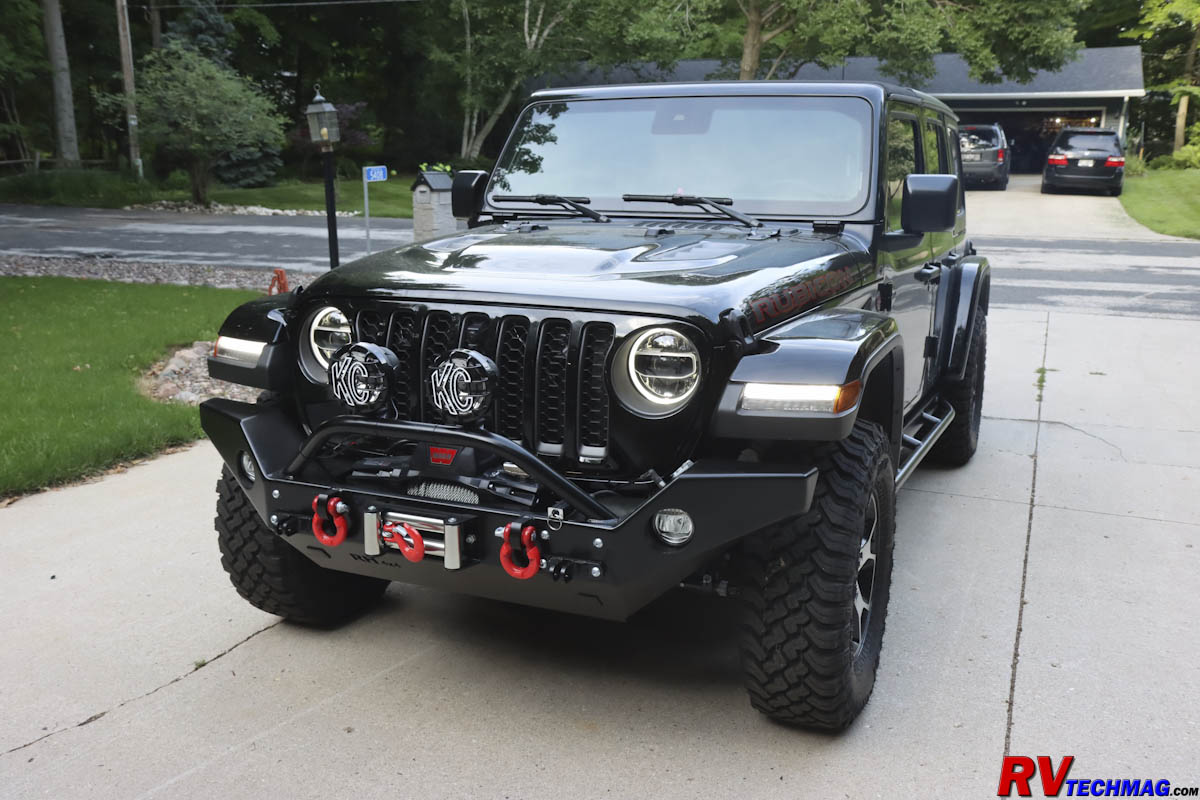
The Jeep Wrangler is a legend in its own right and its go-anywhere, do-anything ability makes it a favorite with
anyone who wants to travel off the beaten path and explore places where the average vehicle won't be able to go. In recent years it's also
been a favorite with the RV community due to its ability to be easily towed behind a motorhome. Jeeps have matured over the years and they
now offer a comfortable ride and the features and amenities that most owners are used to in modern upscale vehicles, all the while retaining
the rough and tumble ability that Jeeps are capable of. Combine that with some great traditional styling and its easy to see why the Jeep
Wrangler is an extremely popular vehicle.
This popularity has caught on with many buyer who buy it for the coolness associated with the Wrangler and it's true
that most of these "mall cruisers" never see any dirt or rock under their wheels unless their garage floor is dusty but there is still a large
contingent of true Jeepers who actually drive them as they were originally intended to be. The Wrangler is a capable vehicle as it rolls off
the factory floor, especially if it's the upper end Rubicon model. The Rubicon is much more than stylish trim and those Rubicon letters on the
hood. It's fitted with a special Rock Crawler transfer case with an extreme 4:1 low range. In addition, stiffer springs and suspension,
electronically locking front and rear differentials, a sway bar disconnect and some off-road performance settings kick it up a notch. Yet, there
is a huge aftermarket industry for everything and anything Jeep that can transform any Jeep into a serious off-roading machine or pimped up mall
cruiser. The Wrangler has more aftermarket gear available from a wide range of aftermarket suppliers than any other vehicle. I've had numerous
Jeps over the years and my latest two vehicles are a 2020 Gladiator Rubicon and a 2021 Wrangler Unlimited Rubicon and thy've all taken advantage
of the aftermarket add-ons. We take our Jeeps to places like Moab and Ouray, where we crawl Moab's red rock canyons or visit Colorado's
ghost towns and old mining trails built for mules carrying ore. We also tow our Jeeps behind a motorhome so it was necessary to mod our Jeeps
so that they could do some serious off-road wheeling while still being able to be towed thousands of miles behind our RV.
Making it Towable
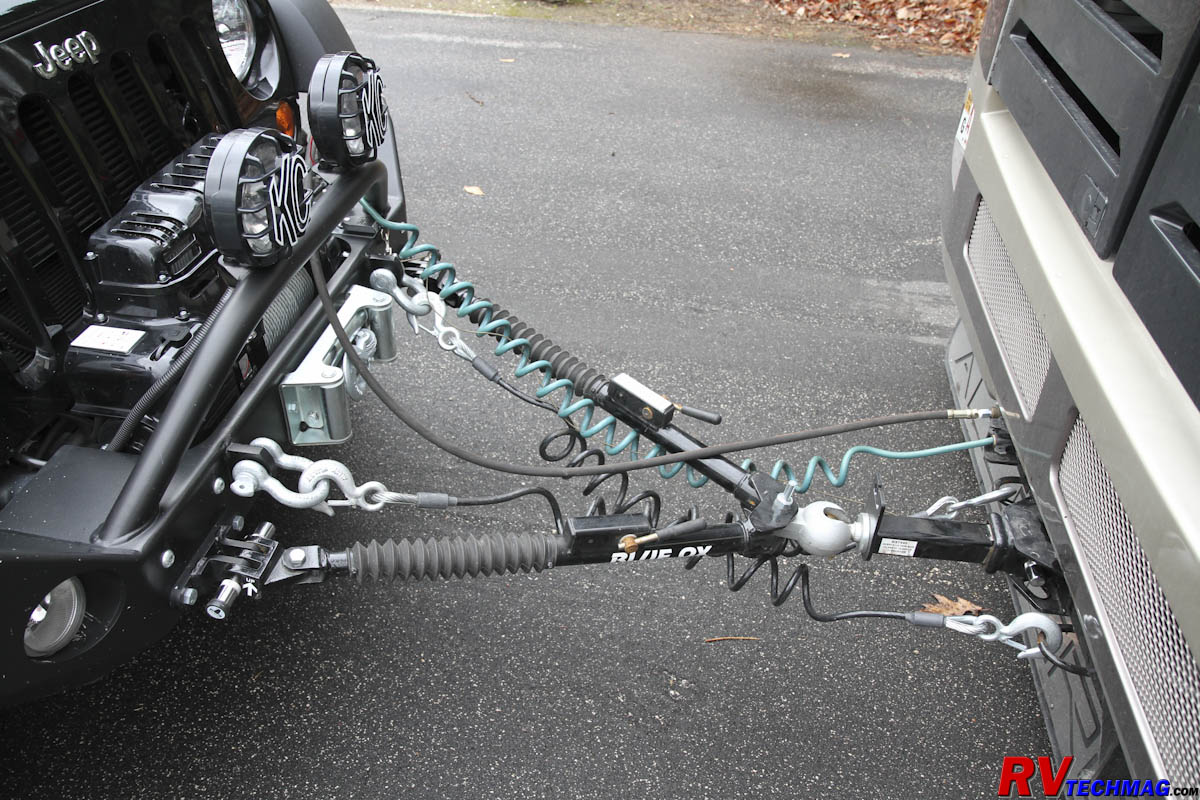
Typical Tow Bar Setup
There are three ways to tow another vehicle behind a motorhome. The first version is to pull a car trailer and drive
the vehicle up onto the trailer. The trailer can be a flatbed or an enclosed trailer. An enclosed trailer is a great choice if you have a classic
vehicle that you want to protect from the elements while a flatbed car hauler is quick and easy. The biggest problem with trailers happens once you
get to the RV park. Many sites don't have room to park a large class A motorhome with a 20' trailer behind it. You'll find that you'll have to unload
your vehicle and then go find a spot where the campground wants you to park the trailer, unhook it and then take the motorhome to your campsite.
That takes time and is inconvenient, especially if a one night stopover. The second method is to use a tow dolly. The tow dolly doesn't take up
as much room as a trailer and can be kept in your campsite, hooked up to your RV. However you do have to drive the vehicle onto the dolly and
secure it. It's generally reserved for vehicles that cannot be flat towed and is a second best option to flat towing. Flat towing, also known as
"four down" involves using as tow bar to tow your vehicle with all four wheels on the road. It's the easiest and fastest way to tow, as long as your
vehicle is capable of being flat towed. In that respect, Jeep Wranglers are perfect for flat towing. You simply attach the tow bar to the baseplate
mounted on the front of the Jeep, clip on the safety cables, plug in your lighting connector and breakaway cable, shift the transfer case into neutral
and away you go.
In order to flat tow any vehicle you must find a way to attach the tow bar to the vehicle. Tow bar manufacturers offer
baseplates that are custom designed for each vehicle that attach to the vehicle's frame and offer a set of mounting lugs that the tow bar connects
to. You just extend the tow bar arms and insert a pair of pins and you are connected. You then connect a pair of safety cables from the
motorhome's hitch to the towed vehicle's connection points, which are usually right on the baseplate, to prevent a runaway should the tow bar fail or
disconnect for any reason. The next step is to connect a lighting umbilical cord from the RV's trailer lighting socket to the auxiliary lighting connection
on your towed vehicle. Various lighting systems are available to allow you to control your vehicles tail, stop and turn signal lighting from the motorhome
when towing. Lastly, it's important to have a supplemental braking system on the towed vehicle to apply its brakes when the motorhome slows down or stops.
There is a wide selection of options from numerous manufacturers to meet those needs but after years of familiarity with many of them I made some
equipment choices, which I'll detail in the next few sections.
Choosing a Tow bar
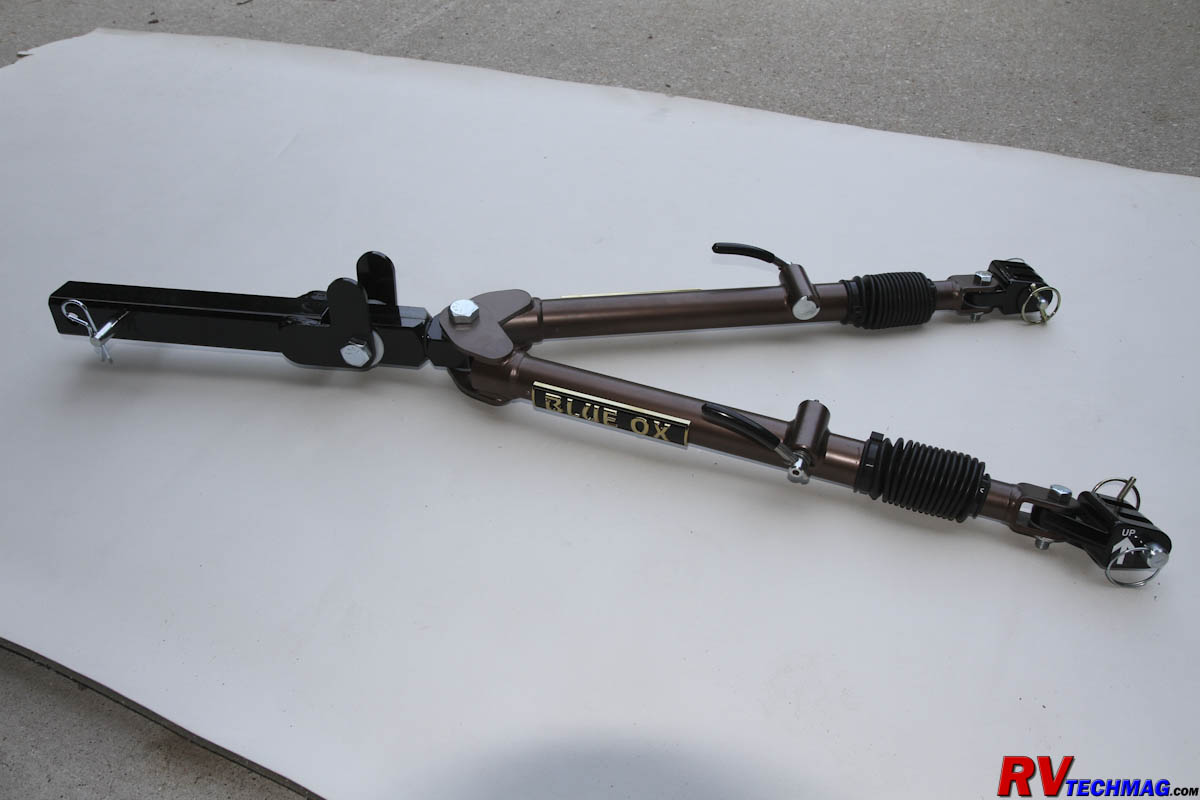
The Blue Ox Avail Tow Bar
There are a few good manufacturers of tow bars. Blue Ox, Roadmaster and Demco are the big three when it comes to choosing and there
are no bad choices among them. They all offer a wide range of tow bars so it's just a matter of picking out the one that appeals the most to you. Keep in mind
that each manufacturer makes their own baseplates so be sure to investigate them as well before selecting your tow bar. In some cases you can buy adaptor
that will allow you to mix one brand of tow bar with another brand's baseplate if you feel so inclined to do so. I've been happy running Blue Ox tow bars for
many years and am happy with them so I decided to stay with them. I will say that when I first started RVing I felt that Blue Ox had a better system than
the others, but that was 20 years ago and I feel that the others have stepped up and are of equal value and quality at this point so I would have no problem
using another brand. I just continued on with what worked for me in the past.
I should also mention that some tow bars are available in steel or aluminum. I still recommend going with steel. The aluminum bars
have a slight weight savings but if you can't handle a steel tow bar you maybe shouldn't be RVing any more. The weight savings are insignificant and the
aluminum bars cost more than the steel bars and they are rated at less capacity. For example, Blue Ox's Avail tow bar is a class IV steel tow bar that
weighs 42 pounds, is rated at 10,000 lbs. and an MSRP of $1,031.50 - although street prices are much less. The aluminum version of this same bar is the Ascent,
which is a class III aluminum tow bar that weighs 31 pounds, is rated at 7,500 lbs. and has an MSRP OF $1,139.75. So you basically pay more to get less with an
aluminum tow bar. Aluminum is also less forgiving than steel and if you ever jackknife one you are most likely going to cause more serious damage to it. Okay,
so much for my rant on aluminum tow bars.
The Blue Ox baseplates attach to the frame rails and have removable tow tabs that can be removed when not towing. This gives you a
cleaner look and pretty much hides the fact that your vehicle is towable four down. It also prevents knocking your shins against them if you walk around the
front of your vehicle. The baseplate also has attachment rings for connecting the safety cable hooks to in order to prevent a runaway and most baseplates will
have a location where you can mount your tow lighting socket that the umbilical cord from the RV will connect to. Baseplates bolt to the frame rails so there
is always the possibility that the fasteners could loosen or fail and the baseplate can fall off your vehicle. In that event you towed vehicle will become
disconnected from the RV and become a ballistic missile. For this reason, Blue Ox supplies additional safety cables or chains that tie the baseplate to the
vehicle's frame rails in the event that would happen.
|
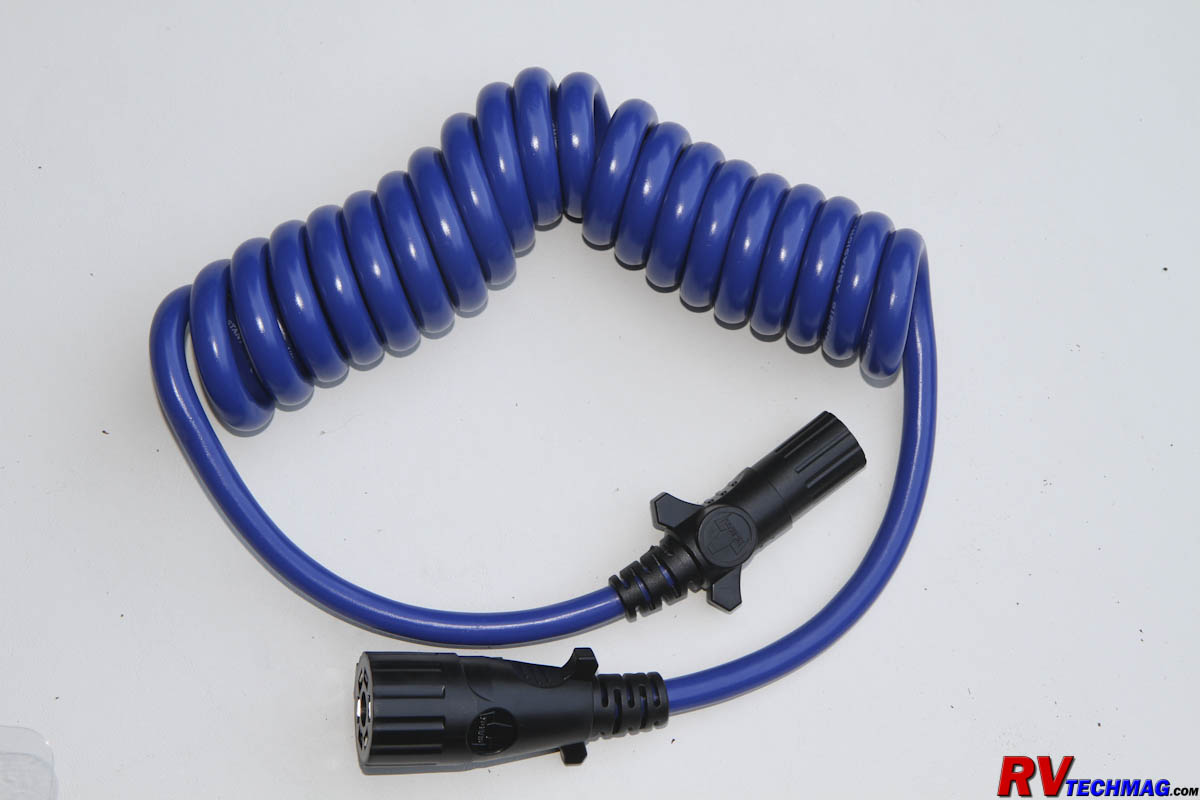
Typical Trailer Lighting Umbilical Cord
|
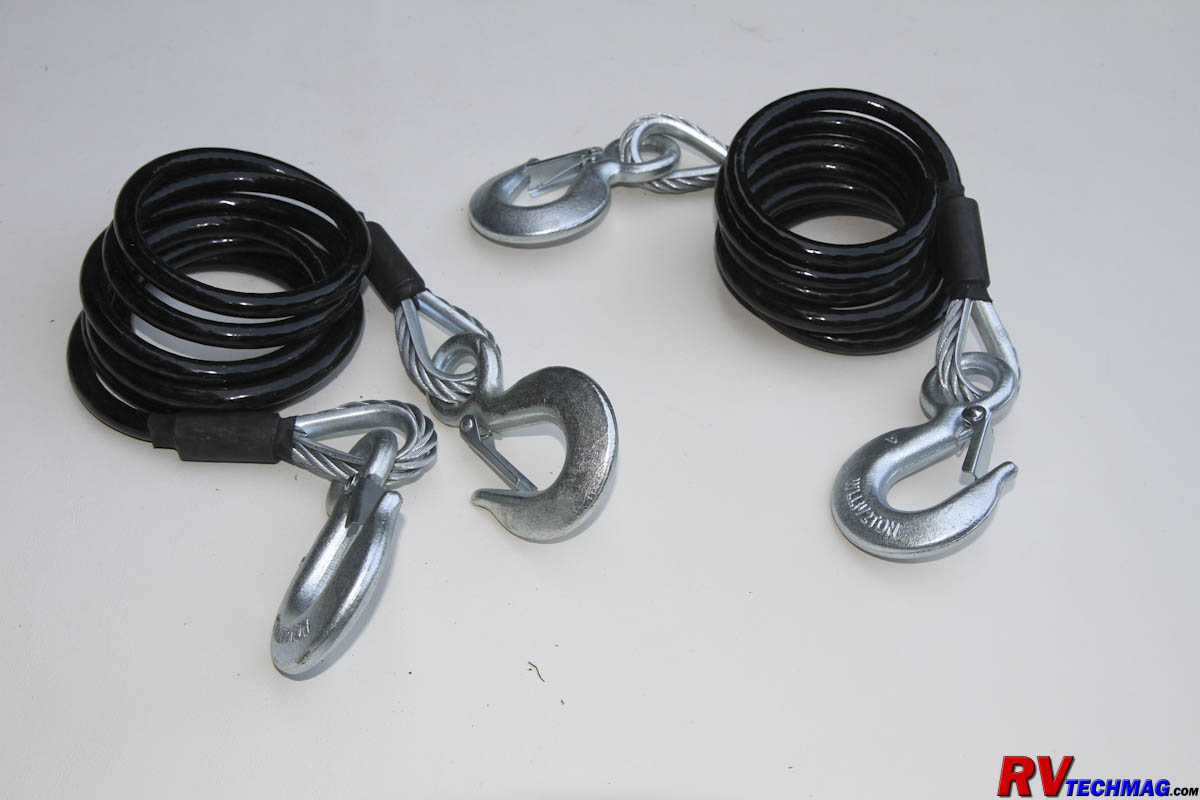
Safety Cables Prevent a Runaway Should the Vehicle Become Disconnected from the Motorhome
|
However, I have had a baseplate in the past on an earlier Jeep. Because of their design, baseplates are mounted low onto the frame rails
which is fine for street driving but can be damaged if driving off-road if they should meet up with as rock. I didn't like that so for this Jeep I choose a Blue
Ox Avail tow bar but skipped the baseplate. Instead I went with a Rockhard steel bumper, which I will cover in more detail in the Off-Road section. Rockhard
offers tow tabs that mount to the bumper so you don't need a baseplate. This keeps the tow bar attachment points up high where they cannot be damaged. It also
lets me attach the safety cables to the D-ring shackles on the front of the bumper.
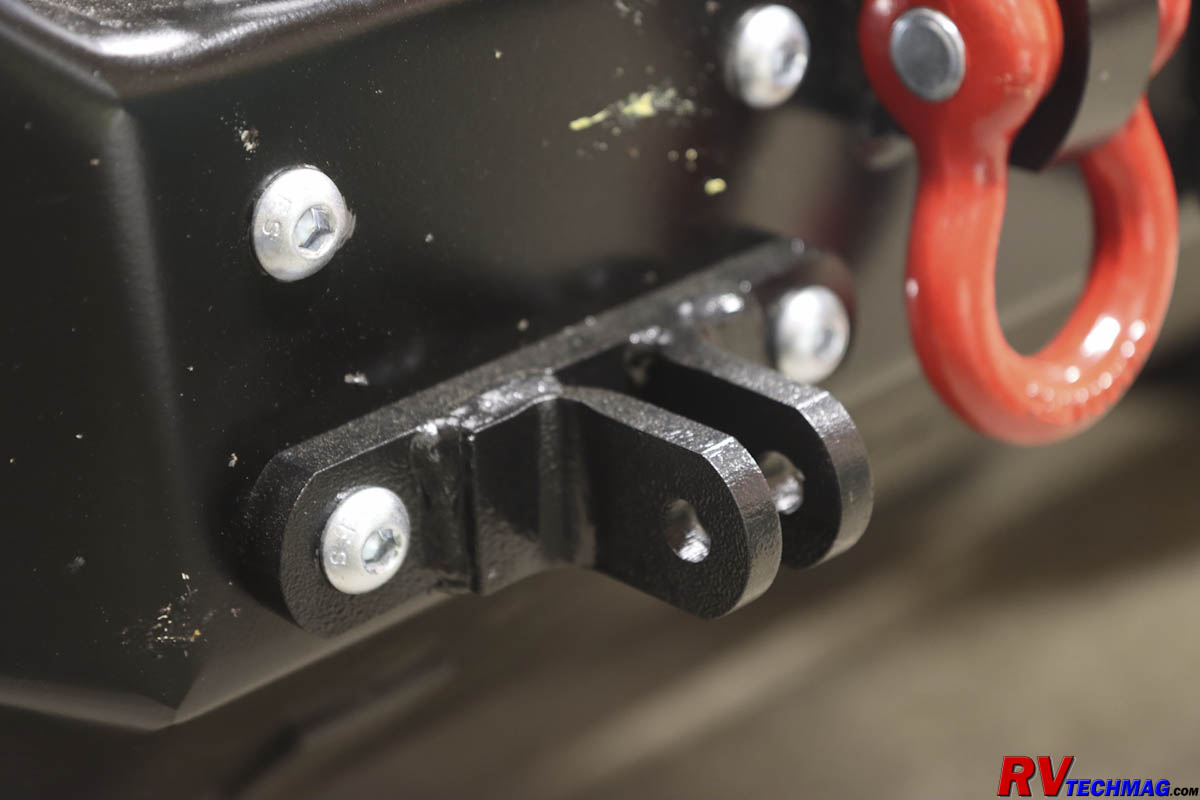
Tow Tabs on the Rockhard Front Bumper for Blue Ox Tow Bars
Tow Lighting
When towing a vehicle you need to control its lighting from the motorhome, just as if it was a trailer. The motorhome will be equipped with
a trailer lights socket, which is most often the 7 pin RV style and tow bar suppliers sell lighting umbilical cords that are used to connect to the towed vehicle.
Most towed vehicles use a 6 pin connector but cords are available with a 7 pin RV plug for the motorhome end and a 6 pin plug for the towed vehicle end. The problem
with towed vehicles is that they already have a lighting system that operates the rear lights, unlike a trailer. In order to control the vehicles lights from the RV
you first have to disconnect or separate the vehicle's light control system so that the RV can take over. There are numerous way to do this. In some cases the taillight
housings are large enough that a second set of bulbs can be installed that would be controlled by the RV. I actually used this method on a Grand Cherokee many years ago
but it's quite rare to find any tail light housings large enough anymore to be able to do this. Another method is to insert a pair of diodes in the wiring to the
taillights. The diodes prevent feedback from the RV side to the towed vehicle's lighting control. This method was very popular but vehicles have gotten more complex
and they can now report if you have a tail or turn light out and will display warnings and errors if it can't find the taillight bulb. A diode system messes this up
and can't be used in this case so diode packs are becoming increasingly rare.
The third method, which is the best, is to totally isolate the RV supply from the vehicle supply to the lights. You can buy wiring harnesses,
such as the Cooltech brand, that intercept your vehicle's wiring and install a switch that you mount in the dash someplace. When the switch is in one position the
vehicles lights operate as normal and there is no connection at all to the RV. When the switch is in the "tow" position the vehicle's lighting circuits are cut out
and the lights are now strictly controlled by the RV. This system works on any vehicle but the caveat is that it takes a bit of wiring to run a bundle of wires to
the switch. There is also the potential to drive away with no turn or brake lights if you forget to flip the switch when you hook up or disconnect from the motorhome.
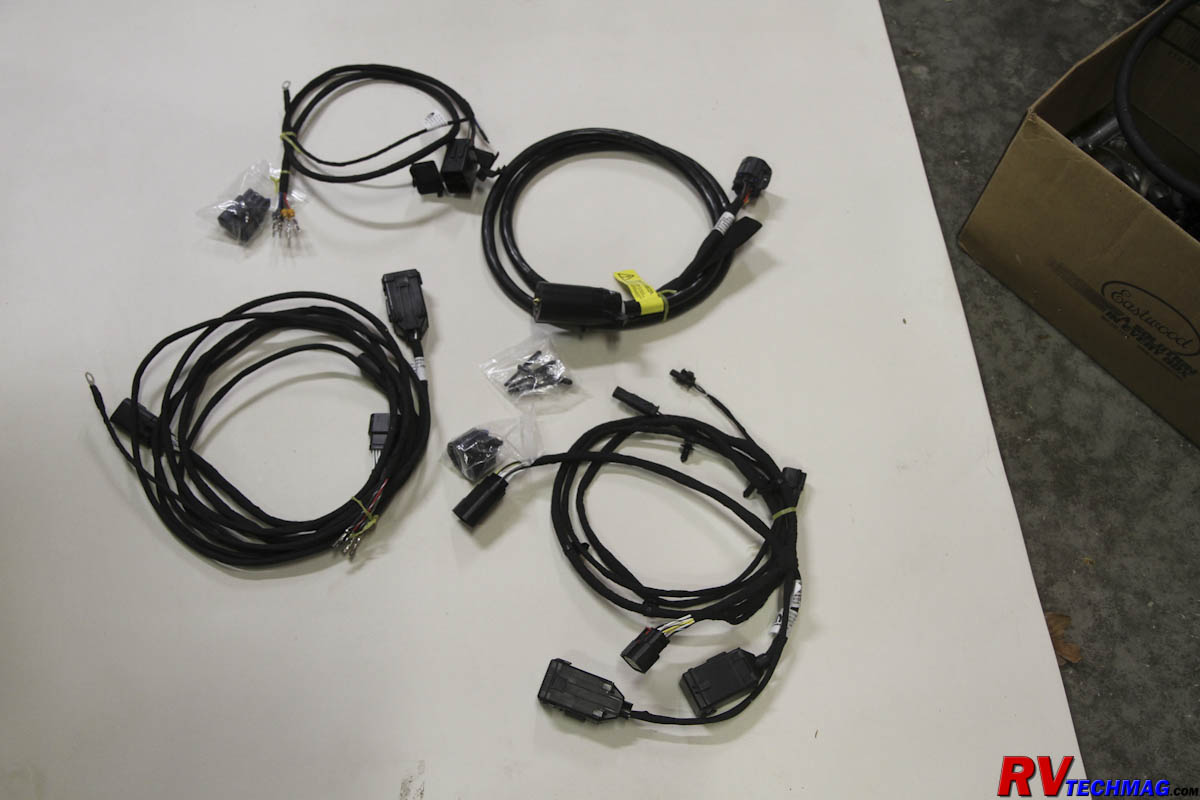
The Mopar Flat Tow Lighting Kit for Wrangler JL Series
Fortunately, there is an alternative. And even better, it's a Mopar item that is designed for your Jeep - by Jeep. This system consists of a
wiring harness that installs into your Wrangler. It's basically plug and play, although it does requi8re fishing wires from the front to the back of the vehicle.
There are breakout plugs that intercept the wiring at the tail lights. Just unplug the lights and insert the breakout plugs into the line. Under the hood is a fused
connection box that connects to the front of the Jeep, where the RV's trailer lighting cord connects to. A set of relays is used to connect the lights to the RV's
control or the Jeep's control. It works similar to the switch I previously mentioned except it uses relays which automatically engage whenever you plug the
Jeep into the RV by sensing power from the battery pin on the RV's trailer lighting cord. There are no switches to have to flip. Just plug in and it works. This
is the system that I chose.
Supplemental Braking Systems
A supplemental braking system is the third necessity when towing. Motorhomes come with a Gross Combined Weight Rating (GCWR). This rating
includes the actual weight of the RV plus the weight of the trailer or towed vehicle. But this weight assumes that you do have brakes on what you are towing. The
GCWR does not mean that the motorhome's brakes are capable of stopping any towed weight so you must have a braking system on whatever you are towing. Supplemental
braking systems come in many different designs. Some are portable units that are placed on the floor by the driver's seat and use an arm to connect to the brake pedal.
Accelerometers detect when the vehicle is decelerating and applies the brakes by depressing the pedal. This method allows for easy portability from one vehicle to
another and in theory do not require any installation, however you still need to connect to a breakaway switch at the front of the vehicle so some installation is
required. These systems require a calibration or setup routine when put in place plus you have to remove it and find a place to store it when you want to unhook from
the RV and drive the vehicle. The accelerometers will also detect when you are descending a grade and may apply the brakes when you don't really want them to when
traveling in the mountains.
A better solution is a permanent installation. While these systems require some installation labor, they are ready to go when you want to tow
and don't take up any room on the driver's floor. Most of these systems utilize a control module underneath the hood that actuate a cable that passes through the
firewall and pulls on the brake pedal arm to actuate the brakes. Some of these systems are electrically actuated while some are pneumatic. The electric systems can
be used on either gasoline powered motorhomes or one with air brakes. The pneumatic systems are designed for diesel powered coaches with air brakes although you can
get an auxiliary compressor system to operate them on a gasser as well, albeit at a larger cost. Most of the electric systems utilize accelerometers to determine
when to apply the brakes but the pneumatic system utilizes an air hose that connects to the coach's air brake system. This system is ideal because the only time the
vehicles brakes will apply is when you step on the brake pedal in the motorhome. This also results in totally proportional braking, which is the best way.
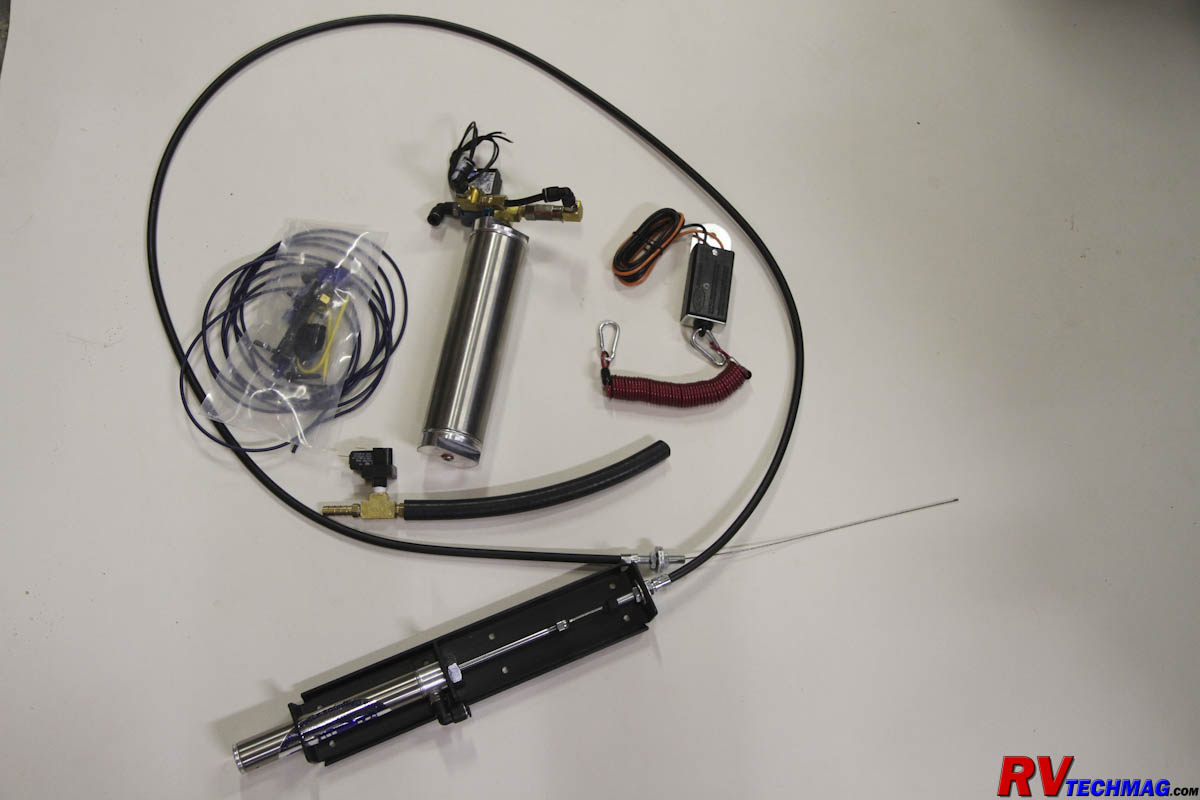
The M&G Engineering 2.0 Supplemental Braking System
Our motorhome is a diesel pusher with air brakes so I chose the
M&G 2.0 Brake System. I've used M&G systems in the past, both the original and the 2.0 systems and am convinced that they are the best choice. The 2.0 system utilizes
the coach air supply, which is tapped into the coach's braking system, to operate a pneumatic cylinder. A stainless steel cable assembly runs from the air cylinder,
passes through the firewall and attaches to a bracket mounted on the brake pedal arm. A quick-disconnect air hose connects the coach to the front of the Jeep. Whenever the
coach's brakes are applied a proportional air feed passes through the hose to the cylinder, applying the Jeep's brakes proportionally to how hard you are stepping on the
brake pedal in the coach. This system requires that the vacuum booster for the power brakes is charged with vacuum. An auxiliary 12 volt vacuum pump is available from
M&G to provide this but most Mopar products already have a 12 volt vacuum pump in them so it's just a matter of tapping into the Jeep's vacuum pump wiring and connecting
it to the hot battery line from the motorhome.
Regardless of what supplemental braking system you have, you do need to install a breakaway system that will apply the vehicle's brakes should it
become disconnected from the motorhome. In theory, your safety cables should prevent the vehicle from running away if the tow bar connection fails but in real life that
isn't always the case and a runaway vehicle could cause damage or even death to another driver should it get loose. A breakaway system will prevent that. Even if the
safety cables do contain the vehicle during a breakaway event, the vehicle could impact the rear of the motorhome, causing damage to both vehicles. I have experienced
just such an event.
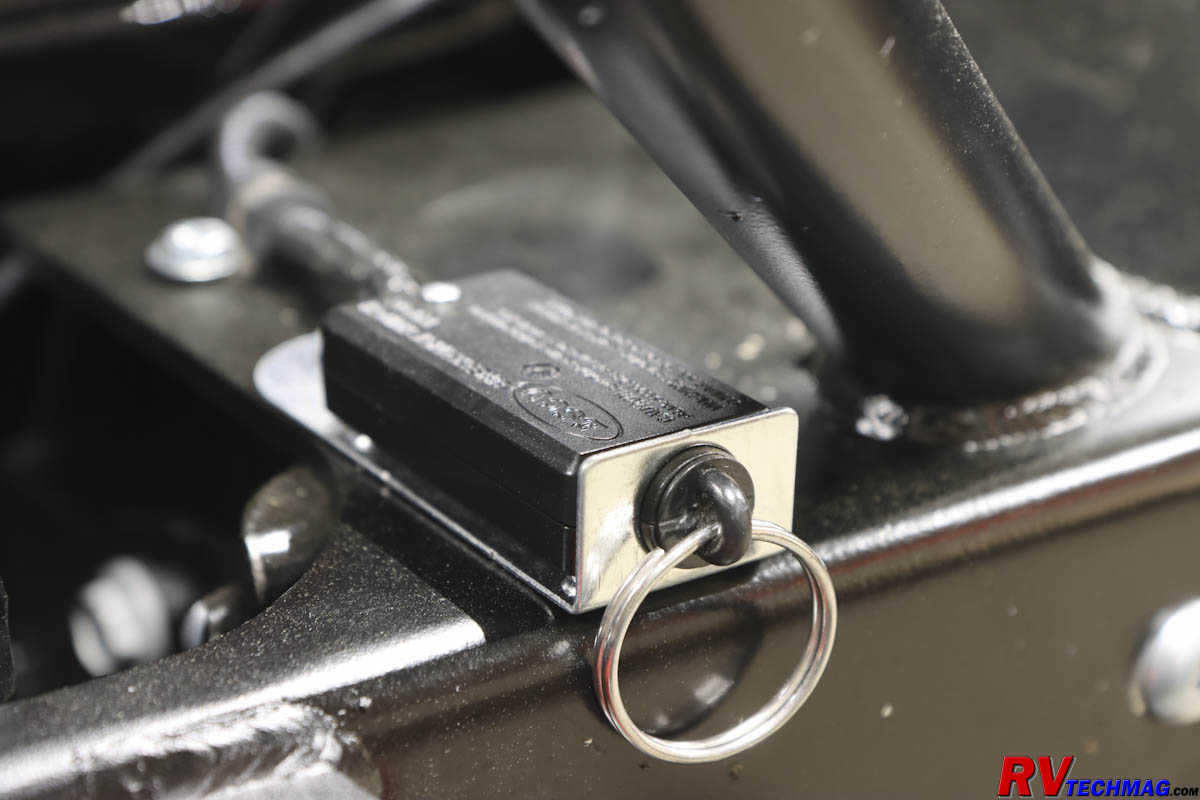
The Breakaway Switch Mounted on the Front Bumper is a Key Safety Component
Just prior to one of our trips I had rebuilt my Blue Ox tow bar, which had plenty of miles on it. I decided to replace the locking pins as well
seeing as how everything else was like new. We left for the trip and after we driving for a while I felt a lurch and looked in my rear view camera surprised to find my
2012 Wrangler following me about 10' behind the motorhome. I knew something was wrong so I pulled over to the side of the road and inspected the tow bar setup. I found
that my brand new 5/8" locking hitch pin that held the tow bar into the motorhome's hitch receiver had sheared, allowing the tow bar to pull right out of the receiver.
The safety cables held fast and prevented the Jeep from running away while the breakaway cable had applied the Jeep's brakes. Had I not had a breakaway in place the Jeep
would have slammed into the rear of the motorhome as I tried to slow down and pull over, damaging both the Jeep and the RV. I simply put everything back together with
a spare pin that I had along and went on my way uneventfully.
All of the above choices will allow me to safely tow our Jeep behind our motorhome. But part of the reason we wanted a Jeep was to do some
off-road travel and the motorhome is merely a way to get to those great destinations. The next step was to make our Jeep ready for some serious off-road wheeling.
Return to Home Page
If you enjoyed this article be sure to recommend RVtechMag.com to your friends, like us on Facebook or Twitter
or subscribe to our RSS feed.



|













